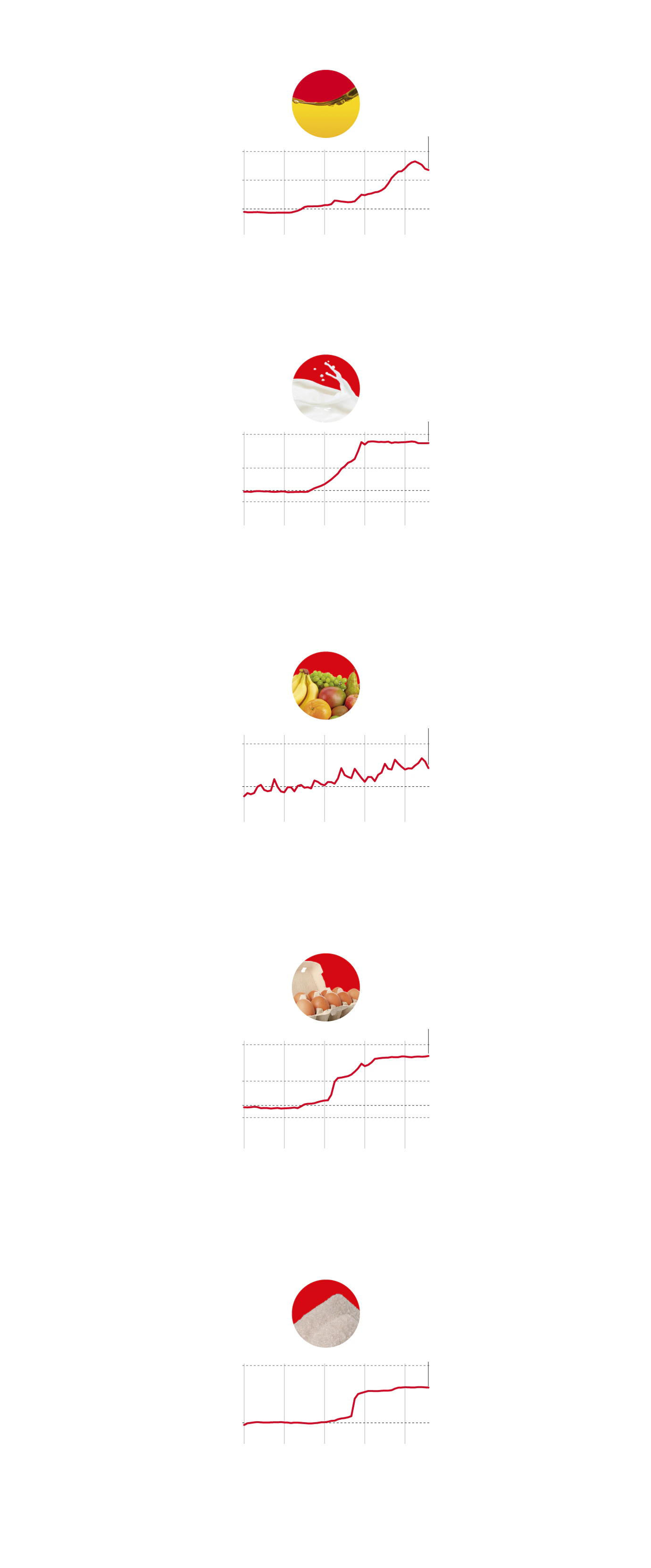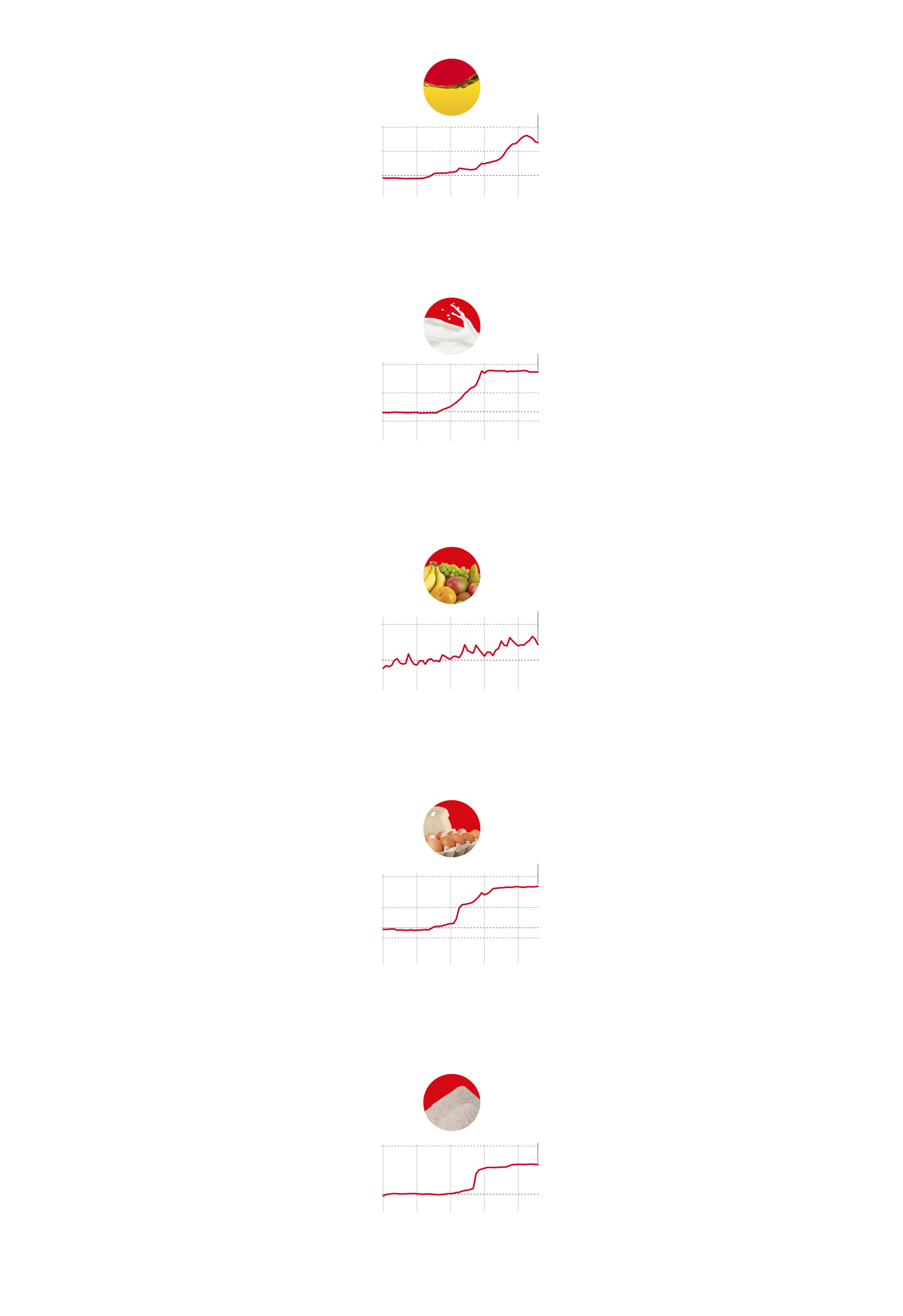Inflation rate drops in Spain but prices are still rising, albeit more slowly
Food prices remain around 30% more expensive than before the coronavirus pandemic and many workers' salaries have not been adjusted to the consumer price index (CPI)
Spending more to buy the same thing, or even less of it. The flattening-out in food prices in recent months - from 15% rises at the beginning of 2023 to just 2.5% in August, according to the latest data from Spain's national statistics institute (INE) - has not yet trickled down to consumers' pockets. The main reason for this situation seems logical: "Lower inflation does not mean that prices are falling, they are still rising, albeit at a slower pace", stated María Jesús Fernández, senior economist at Funcas.
In other words, inflation in September 'fell' to 1.5%, the lowest in three years. Still, this does not mean a decrease, but rather that prices in Spain have risen by 'only' 1.5% compared to September last year, a figure much lower than the increases of a few months ago.
What is more, since December 2019, before the pandemic, "food and drink is the item that has increased the most within the general CPI, an accumulated 30%, much more than energy bills, contrary to the perception we have", says Pedro Álvarez, economist at CaixaBank Research, with products such as olive oil, sugar and eggs completely skyrocketing.

Evolución de los precios de cinco alimentos básicos (en base 100)
Aceite
235,6
300
200
100
2020
2021
2022
2023
2024
262%
Leche
142,3
150
120
90
2020
2021
2022
2023
2024
44%
Frutas
121,7
150
100
2020
2021
2022
2023
2024
37%
Huevos
140,7
150
120
90
2021
2020
2022
2023
2024
43%
Azúcar
161,6
200
100
2021
2020
2022
2023
2024
68%
Fuente: INE
L. CARVAJAL

Evolución de los precios de cinco alimentos básicos (en base 100)
Aceite
235,6
300
200
100
2020
2021
2022
2023
2024
262%
Leche
142,3
150
120
90
2020
2021
2022
2023
2024
44%
Frutas
121,7
150
100
2020
2021
2022
2023
2024
37%
Huevos
140,7
150
120
90
2021
2020
2022
2023
2024
43%
Azúcar
161,6
200
100
2021
2020
2022
2023
2024
68%
Fuente: INE
L. CARVAJAL

Evolución de los precios de cinco alimentos básicos (en base 100)
Aceite
235,6
300
200
100
2020
2021
2022
2023
2024
262%
Leche
142,3
150
120
90
2020
2021
2022
2023
2024
44%
Frutas
121,7
150
100
2020
2021
2022
2023
2024
37%
Huevos
140,7
150
120
90
2021
2020
2022
2023
2024
43%
Azúcar
161,6
200
100
2021
2020
2022
2023
2024
68%
Fuente: INE
L. CARVAJAL

Evolución de los precios de cinco alimentos básicos (en base 100)
Aceite
235,6
300
200
100
2020
2021
2022
2023
2024
262%
Leche
142,3
150
120
90
2020
2021
2022
2023
2024
44%
Frutas
121,7
150
100
2020
2021
2022
2023
2024
37%
Huevos
140,7
150
120
90
2021
2020
2022
2023
2024
43%
Azúcar
161,6
200
100
2021
2020
2022
2023
2024
68%
Fuente: INE
L. CARVAJAL
One of the factors that has weighed most heavily in this upward spiral has been the increase in the cost of producing said items, especially when looking at the rise in energy prices at the beginning of the crisis. However, current petroleum levels "are around 20% lower than those of the same period in 2023", explained Santiago Martínez Morando, head of economic and financial analysis at Ibercaja. This suggests that, with this drop, supermarket prices should also be lower. However, this is not the case. "Although the production costs that raised prices at the time - in reference to energy - have been reduced, there are others that are still higher and are putting upward pressure, as with the prices of agricultural raw materials needed by farmers such as fertilisers, seeds, etc.", said Fernández from Funcas. The price of animal feed, which accounts for 50% of a farmer's costs, has also levelled off. "But if we look at the accumulated costs, the 20% drop in production costs that has occurred in the agricultural sector since the highs of 2022 does not make up for the increase we have seen since before the pandemic," said Álvarez from CaixaBank Research. Moreover, according to his team's calculations, current production costs are still 22% higher than they were before the inflationary cycle.
In this scenario, and according to data compiled by the consultancy NIQ, the price of our shopping basket rose by 1.7% in August compared to last year. Food increased in price by 1.8% in that month, while drinks rose by almost 1%. There was also increased activity in the dairy category, with cheeses increasing their sales by almost 15% in August and butter by 10%.
"Although the production costs that drove up prices at the time - in reference to energy - have been reduced, there are others that remain above them and put upward pressure on prices."
The case of olive oil still stands out and, after months of relentless price rises, demand for it is falling among Spanish consumers. As a result, the NIQ report indicates that purchases of this product fell by 8.3% in August. Juice purchases also fell by 4%, cereals by 3.5% and milkshakes by 2.6% compared to a year ago. These are precisely some of the products that rose most in price during the month. "The trends indicate that we are returning to normality, but we must not forget that we have been experiencing sustained growth over the last two years", explained Patricia Daimiel, general manager of NIQ Iberia, who reminds us that we still have to wait to compile the data for October to see how the rise in IVA (sales tax in Spain), which has been applied to basic foodstuffs since 1 October, has affected prices. On this point, Carlos Balado, professor at OBS Business School and director of Eurocofin, reiterates that, in the context of rising prices like the one we are experiencing, the IVA applied to foodstuffs will have an "accelerating" effect.
Back to the past
The experts also point out that "the long production processes in the field mean that the transmission of the decrease in production costs takes months to reach final prices." The same is true of product harvests, which are heavily impacted by meteorological factors that are now beginning to improve.
In fact, according to CaixaBank Research, the percentage of Spain's land classed as being in prolonged drought is currently around 12%, down from the terrible 45% recorded in October 2022. In this scenario it is worth asking whether we will ever again see a litre of oil at three euros or be able to order a coffee with milk in a bar for 1.20 euros. The answer is simple: never. "Once the price of a soft drink or a loaf of bread goes up, whoever sells it is not going to make it cheaper, it stays that way," experts warn. But not only that. They point out that inflation is an average of many products and services that, in order for prices to fall, would have to fall a lot. So, to go back to the past, there would have to be deflation - in other words, a generalised and constant fall in prices that central banks are not willing to allow, as it implies certain risks for the economy, such as a slowdown in consumption. "It is impossible. Food prices have been levelling out for several months now and may do so further - with falls in some specific products that can already be seen in month-on-month terms - but they will not return to previous levels because there are other costs that have already become fixed, permanent", explained María Jesús Fernández.
Fernández refers to wage rises that also mean higher costs for the companies that form part of the entire production chain. "Although costs such as energy costs are falling, wage costs have remained at a high level and this prevents food from returning to pre-crisis levels."
It is true that the improvement in wages has allowed some recovery in purchasing power this year. But the gap between people's wages and prices is still huge compared to the beginning of the inflationary crisis.
"If we go by the labour cost surveys (the wages part), wages increased by 4.8% last year and so far this year by 3.9%," Funcas points out. "But with respect to the first half of 2021, the rise has been 12.8%, compared with an accumulated increase of 16.6% in prices." In other words, consumers have not yet fully recovered their purchasing power and will continue to feel the impact of inflation for a long time.

